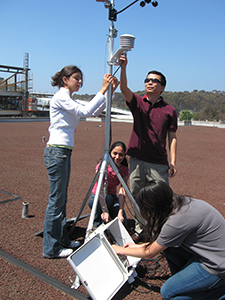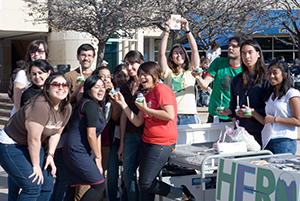Turning a Deeper Shade of Green
Increasing number of undergraduates seeking place in green economy.
Rex Graham | Dec. 13, 2010
Undergraduate education at UC San Diego took on a deeper shade of green this year in most academic areas. In some cases, more teaching-assistant resources were needed, and some labs and classrooms ran out of space for the ever-increasing surge of students seeking environmentally focused majors, minors and classes they need to prepare themselves for jobs in the green economy.
Students majoring in Environmental Engineering jumped from 92 last year to 157 this academic year and Environmental Systems (ESYS) majors increased from 200 to 270 during the same period.

UCSD students working on an environmental sensor network project.
“UC San Diego strives to prepare students to be global citizens equipped with the tools required for leadership in today’s world,” said Suresh Subramani, UC San Diego’s Acting Senior Vice Chancellor for Academic Affairs. “It is heartening to see such a strong demonstration of global stewardship among our undergraduate student population. Their intellectual curiosity transcends traditional disciplinary boundaries and reflects the dynamic research collaborations in this field across the campus.”
Ecology and Behavioral Evolution (EBE) has become an increasingly popular major. Currently, there are 170 Biology EBE majors and another 167 ESYS majors with a focus in EBE. Currently, there are too few faculty members in the EBE program to handle the growth in demand.
Students’ interest in green courses extends to virtually all departments, schools and programs. For example, two courses in the department of economics – Energy Economics and Economics of the Environment – grew from 503 last year to 524 this academic year, an increase that required the department to add more teaching-assistant resources. Faculty members see good reasons behind the continued high interest in environmental economics.
“Major changes in the regulatory environment are producing substantial changes in how businesses and governments work and there is a growing awareness by industry that poor environmental performance on key indicators is harmful to a company’s value,” said Richard Carson, a professor of economics who has extensive experience in the assessment of the benefits and costs of environmental policies. “Our courses are also popular because economic analyses provide key insights into why some solutions work, some don't, and why some solutions are more cost effective than others.”
Green Organizations Created by Students
Students with green majors are also increasingly involved in environmentally focused internships, research opportunities and student organizations. Green student organizations include:
- BioFuels Action and Awareness Network.
- Global Environmental Brigades.
- Human and Earth Rights Organization.
- International Ambassadors of Philanthropy.
- One Earth One Justice.
- The Roosevelt Institute.
- Student Sustainability Collective.
- USGBC Student Group.
|

Members of UC San Diego student organizations hand out free fair trade ice cream on Library Walk.
|
Barrett Hammond, a junior majoring in communications, created International Ambassadors of Philanthropy to give all UC San Diego students a place to share news, information and excitement about their green causes. “We offer busy students with an interest in any cause or organization in the world to use our organization to tell their peers about it as a way to help raise money for any organization, whether it’s green, yellow or turquoise,” said Hammond. “I call myself a social action entrepreneur.”
Students Drawn to World-Class Faculty
This year’s 70 percent growth in the Jacobs School of Engineering’s Environmental Engineering Program is largely due to students’ eagerness to learn with faculty members who are world leaders in solar power, biofuels and climate change. The Environmental Engineering Program is based on interdisciplinary links to Scripps Institution of Oceanography, the department of chemistry, and departmental programs such as Urban Studies and Planning as well as the Environmental Systems Program.
Even Freshman Make Green Impact
Nitya Timalsina, a freshman majoring in environmental engineering, is working on water filtration systems and small hydroelectric power sources intended for countries in Southeast Asia and India and Nepal (her birthplace). Timalsina has worked with Rotary International, Engineers Without Borders, and San Diego water authorities as part of her plan to obtain funding that will allow her to set up water systems in the field by the end of 2011.
Undergraduates like Timalsina are able to find mentors, develop green projects, and find out about internships and other sustainability resources at the campus’ Sustainability Resource Center, a bustling collection of offices, meeting rooms and a library at the Price Center. The center’s countertops are made of recycled cardboard or glass, the cabinets were built with boards made from the post-harvest stalks of the sorghum plant and the carpeting is made from 100 percent recycled material. Direct current from solar panels on the roof is used to power the energy-efficient lights.
The Student Sustainability Collective, a student organization operates as a student-managed subset of the Sustainability Resource Center, providing a space for the community to “institutionalize sustainability at the university.”
Internships Offer Real-Life Experiences
About 40 students majoring in Environmental Systems are involved in fall and winter internship projects. These real-life experiences better prepare students as they enter the local workforce or continue their studies in graduate school. “We have several students working on local solar issues,” said Jane Teranes, associate director of the ESYS program. “Travis Bass is an intern with Gecko Logic up in North County, and Frances Ho is an intern with URS Corporation and is working on Calico Solar and Imperial Valley Solar projects.”
Green Giant: Scripps Institution of Oceanography
More than 1,700 undergraduates with a wide range of majors took advantage this year of the 45 regularly offered courses and seminars at Scripps Institution of Oceanography. One of the most popular new courses at Scripps is Climate Change and Society. Over the past three years, more students are opting for the Earth Sciences major and Marine Science minor as they prepare for careers in ocean and earth sciences and environmental fields.
Research an Option for Undergraduates

UCSD environmental engineering freshman Ntiya Timalsina.
Undergraduates are increasingly interested in participating in faculty research projects. For example, this year alone, more than 50 students worked with Scripps researchers. Timalsina is working on a solar-irradiation study under the guidance of Jan Kleissl, a professor of mechanical and aerospace engineering who is a favorite of students for providing in-the-field projects using novel technologies for renewable-energy solutions.
“This helps young people get the idea that there’s something interesting going on here,” Kleissl said. “Solar energy is a big growth area for environmental engineering.”
Students Create Solar Solution in Kenya
Engineering students are also combining solar energy with humanitarian projects. For example, the Jacobs School of Engineering’s Global TIES (Teams in Engineering Service) Program travelled to Kenya last summer to the off-the-grid island community of Mbita on the east side of Lake Victoria. The students used solar panels to create a portable charging station to power and recharge cell phones, lanterns, water purifiers, medical devices, and other critically needed technologies. The solar prototype is part of a larger Global TIES project to help the San Diego Chapter of Engineers without Borders bring electricity to a new technology and adult education center in Mbita.
“It opened our eyes to how many problems there were that could be easily solved by students, by engineers,” said Anita Prasad, a team leader for the Global TIES project in Kenya who graduated in June 2010 with a bachelor’s degree in mechanical engineering. “I think programs like Global TIES can really empower students – and help change the world.”
Read related stories on UC San Diego gravitating towards Green:

|